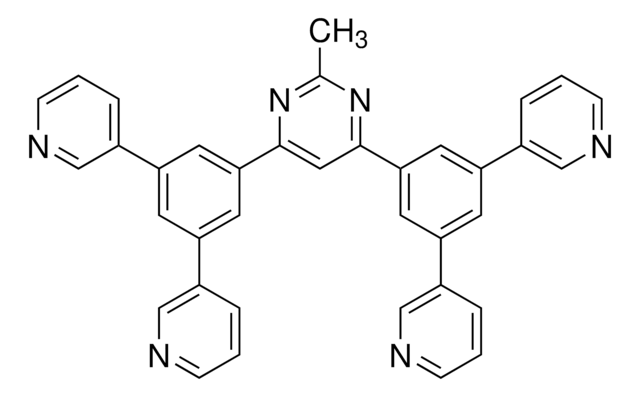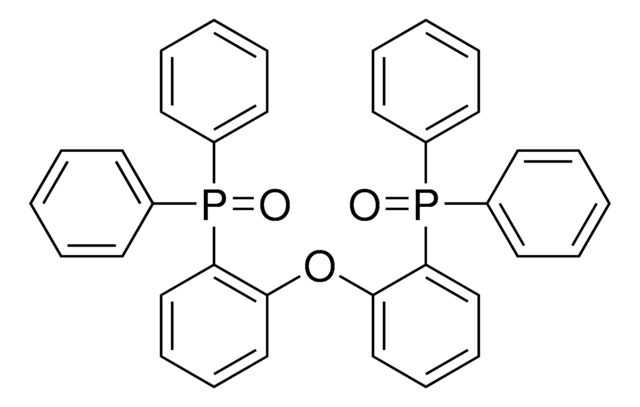Kluczowe dokumenty
932361
1,3,5-Tri[(3-pyridyl)-phen-3-yl]benzene
≥99% (HPLC)
Synonim(y):
TmPyPB
About This Item
Polecane produkty
klasa czystości
sublimed grade
Poziom jakości
opis
μe ≈ 1.0 x 10-3 cm2 V−1 s−1
Próba
≥99% (HPLC)
strata
0.5% TGA, > 310 °C (weight loss)
mp
195-200 °C
temp. przejścia
Tg >310 °C ((0.5% weight loss))
rozpuszczalność
chloroform: soluble
dichloromethane: soluble
fluorescencja
λem 353 nm in dichloromethane (PL)
Energia orbitalna
HOMO 6.75 eV
LUMO 2.75 eV
λ
in dichloromethane
absorpcja UV
λ: 254 nm Amax
ciąg SMILES
C1(C2=CC=CC(C3=CN=CC=C3)=C2)=CC(C4=CC=CC(C5=CN=CC=C5)=C4)=CC(C6=CC=CC(C7=CN=CC=C7)=C6)=C1
InChI
1S/C39H27N3/c1-7-28(34-13-4-16-40-25-34)19-31(10-1)37-22-38(32-11-2-8-29(20-32)35-14-5-17-41-26-35)24-39(23-37)33-12-3-9-30(21-33)36-15-6-18-42-27-36/h1-27H
Klucz InChI
CINYXYWQPZSTOT-UHFFFAOYSA-N
Szukasz podobnych produktów? Odwiedź Przewodnik dotyczący porównywania produktów
Powiązane kategorie
Zastosowanie
Kod klasy składowania
11 - Combustible Solids
Klasa zagrożenia wodnego (WGK)
WGK 3
Temperatura zapłonu (°F)
Not applicable
Temperatura zapłonu (°C)
Not applicable
Wybierz jedną z najnowszych wersji:
Certyfikaty analizy (CoA)
It looks like we've run into a problem, but you can still download Certificates of Analysis from our Dokumenty section.
Proszę o kontakt, jeśli potrzebna jest pomoc Obsługa Klienta
Masz już ten produkt?
Dokumenty związane z niedawno zakupionymi produktami zostały zamieszczone w Bibliotece dokumentów.
Nasz zespół naukowców ma doświadczenie we wszystkich obszarach badań, w tym w naukach przyrodniczych, materiałoznawstwie, syntezie chemicznej, chromatografii, analityce i wielu innych dziedzinach.
Skontaktuj się z zespołem ds. pomocy technicznej







![Di-[4-(N,N-di-p-toliloamino)-fenylo]cykloheksan ≥97% (HPLC)](/deepweb/assets/sigmaaldrich/product/structures/111/787/16bde1ce-c76d-46d6-9e1f-9ce09f82d038/640/16bde1ce-c76d-46d6-9e1f-9ce09f82d038.png)
